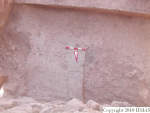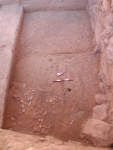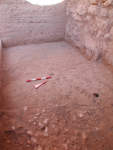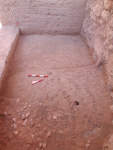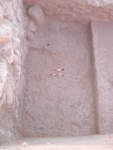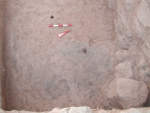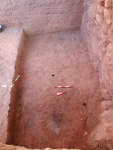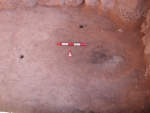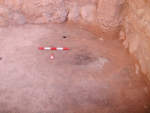1. OVERVIEW
| Roster | Date | Author | Record |
|---|---|---|---|
| Best image | 2014-10-24 | cJC |  [Input: YX24CJC.j] [Input: YX24CJC.j] |
2. IDENTIFICATION
Designation
| Roster | Date | Author | Record |
|---|---|---|---|
| Description (summary) | 2005-08-24 | fAB | SE corner of k13, immediately east of k101. [Input: P913MH3.j] |
3. STRATIGRAPHY
Recovery/Assignment
| Roster | Date | Author | Record |
|---|---|---|---|
| Daily notes about recovery of elements | 2005-08-25 | sC | Today we continued to dig f231, after having removed f227 on the north-eastern area of the square (the layer of pottery sherds; yesterday we collecet one qlot -qlot558-, and today another one, qlot594). f231 is a compact surface with a fine texture, well defined in term of texture and consistence from f229 (above it), and therefore very easy to differenciate from the accomulation above. It is the same of f234 in k101, altought they differ in elevation: probably, this could depend by the general slope that characterized this area. f231 is a bit plastic (when wet) leaving a light brown colour on fingers, while dry it has a grayish coloration. like f234 (in k101) also f231 presents a difference between the top elevation in the N and the top elevation within the square: the top elevation of f231 in the N area is m3953 +31 -165 while on the S is m3953 +21 -165. f231 covered another well defined surface f236 (with a very fine texture and compact consistence, reddish-brownish in color), that was overlayed, on the south-eastern area, by a layer thick layer of pottery sherds and pebbles (f235, which limits have been defined with a relay, r743). I moved Masum in k103 in order to help Kamiran to expose this layer of pottery sherds. [Input: P825SC.j] |
| 2005-08-27 | mH | We started by removing what we thought were the remains of f240 (q617). Underneath the removed area, however, we found more of similar brown soil with an ash lense roughly in the middle of the locus. Since the spoil color, texture, and composition did not differ from that of f240, we considered this to be part of the same feature. We relayed the approximate center of the ash lense (r747), gave feature numbers to the two rodent holes in this unit (f250 and f251) and relayed them (r745 and r746, respectively) and continued the excavation (f240 q624). Underneath we discovered another brown layer (f246), and following the the northern edge of the locus, a gray layer (f247), which seemed to go under f246. This equals f248 in k101. At the end of the day we decided to combine k101 and k103 as k104 starting tomorrow. [Input: P827MH.j] | |
| Argument | 2005-08-25 | sC | Altough there were a lots of pottery sheds lying in a horizontal way, especially in the periferics edges of f235, I considered f235 as an accomulation rather than a floor surface; there were some pottery sherds lying in a vertical way (expecially in the central area). Also f235 presents a slope toward the south area of k103: the top elevation of f235 in the N area is m3953 +21 -166 while on the S is m3953 +12 -166. It is a thin layer : about 3-7 cm; the soil between the sherds has a clay loam texture (sticky and a bit plastic). Once exposed we took a picture of f235 and of f236 (gv104, gv104a and 104b) and we start to remove f235 (qlot 604, qlot 608 and qlot 609). Therefore we start removing f236: before start digging the feature we remove the dirty from the the two animal holes (f250 and f251) that intruded f236 in the south and central area of k13. [Input: P825SC.j] |
| 2005-08-25 | sC | Toward mid day vvE came in the field for let me know that the last qlot from the pottery colum have been dated by mKB to phase 1 (altought we need to wait before thinking that we area really in phase 1, because just 5 shapes have been recognized by mKB and the sherds are prevantly wall of pottery vessels). [Input: P825SC.j] |
Volumetric Localization
| Roster | Date | Author | Record |
|---|---|---|---|
| Elements within locus | 2005-08-23 | fAB | f231 (floor, type b) [Input: P913MH.j] |
| 2005-08-23 | sC | f235 (floor, type b) f236 (accumulation B) f238 (floor, type b) f240 (accumulation B) f245 (accumulation B) [Input: P913MH.j] |
|
| 2010-12-30 | cJC | f246 (accumulation D) [Input: U809YM.j] | |
| 2005-08-27 | sC | f247 (accumulation D) f250 (rodent hole) f251 (rodent hole) [Input: P913MH.j] |
|
| 2005-08-25 | sC | q594 (bones, pottery) q595 (pottery) q598 (bones, pottery) q601 (pottery) q604 (pottery) q606 (pottery) q608 (pottery) q609 (pottery) q610 (bones, pottery) [Input: P908MH2.j] |
|
| 2005-08-27 | sC | q617 (bones, pottery) q620 (pottery) q624 (bones, pottery) [Input: P908MH2.j] |
|
| 2005-08-27 | mH | q629 (bones, pottery) [Input: P908MH2.j] | |
| Extension of locus or q-lot | 2005-08-24 | fAB | r710 [Input: P913MH3.j] |
| Length of two sides | 2005-08-24 | fAB | 200e [Input: P913MH3.j] |
| 2005-08-24 | fAB | 200s [Input: P913MH3.j] |
